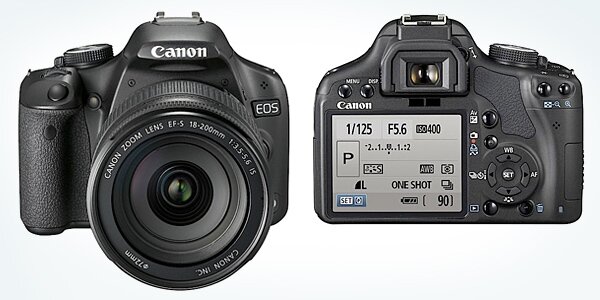Using the Canon T1i for Asset Gathering
From SD to HD

Canon GL1 on the left; Canon VIXIA HF100 on the right.
About a year ago, I finally sold the GL-1 I’d bought in film school and purchased my first-ever High-Definition Camera, the Canon HF100. “Finally”, I thought, “No more worrying about tapes or real-time digitizing – just a few 16GB Memory Cards and I’ll be golden.” Well, I was right about real-time digitizing being a thing of the past. It turns out that the flavor of AVCHD the HF100 uses is pretty useless in its native format. To be able to edit with the .MTS files it creates (or even view them decently), you need to transcode – which takes much longer than realtime, and gave me humongous files that ate up my external 500GB drive in no time. Additionally, you can’t shoot in SD – your only option is to shoot lower-bitrate HD files. Honestly, I mostly wound up playing the videos directly off the camera, through an A/D converter box, bringing it in as classic (downscaled) DV Video so I could work with it.
Additionally, working with the HF100 was a huge step back from my days with the GL-1. It was smaller and lighter, for sure – the HF100 easily slips into a cargo pocket for on-the-go and stealth shooting – but focusing with a four-way rocker switch just doesn’t cut it.
The DSLR Video Revolution

Reverie - Vincent Laforet
Like many, I was floored by Reverie – Vincent Laforet’s visually stunning short showing off the Canon 5D MKii. After a quick price check on the 5D MKii, I concluded that while the tech was amazing, I just couldn’t justify it as a Motion Graphics artist. I’d often run across shot with the 5D MKii, and simply sigh.
Finally, It’s Affordable

Canon T1i
Enter the Canon T1i. At $800 for Body + Kit Lens, it’s Canon’s first foray into offering DSLR Video at the consumer-level, and there’s a lot they got right. You can record in 720p or 480p (technically, you can do 1080p as well, but only at 20FPS, so I’m not counting it). You get manual focus and zoom rings, since they’re built into the lens, not the camera. On that note, you can use any Canon EF-mount lens, so once you outgrow the 18-55 kit lens, you can invest in a new lens and gain another level of shooting ability with the camera, without having to buy a new body (which is the norm in consumer-level video cameras).
After dealing with the HF100’s .MTS files, the movies that come off the SD Cards in the Canon T1i are a blessing. They are H.264-compressed .MOV files. On my MacBook Pro, that means I can preview and play them directly from the card, or from my drive after a quick drag-and-drop. No longer is it necessary to transcode for hours just to preview the clips on my machine and make my picks. The files load right into After Effects or Motion for quick sketching of ideas. When I edit narrative videos, I do transcode – but it makes such a difference to have the ability for instant playback and manipulation when that’s all I need.

These are stills pulled directly from the original movie file. The image on the left was shot with the kit lens, the one on the right was shot with the Canon 50mm f1.4, about a minute later.
The picture quality is also, I feel, quite a leap beyond the HF100 or your standard consumer camcorder. You’ve got real Depth of Field, and with the right lens you can get an amazing exposure range – shooting footage for my friend’s wedding in a shady grove in the evening was delightful with the help of a 50mm f1.4 lens.
For the full specs, check out DPReview’s in-depth testing of the camera.
The Downsides
The camera is by no means perfect. Some of the areas that could use improvement:
- There is no way to plug in an external Mic, so you’ll need a separate sound recorder if you want decent location sound.
- Autofocus is slow in video mode.
- Low-light prime lenses don’t have built-in Image Stabilization. It’s bad enough that you’ll want to stick to a tripod.
- Exposure controls are automatic in Movie mode. This was fixed on the 5D Mkii with a firmware update, but there’s no word of a similar update to the T1i, probably to keep this as more of a consumer model.
- Shooting time – the camera leaves the shutter open during movie recording, and the manual (and the camera) warns that leaving the camera in this state for too long could cause image degradation.
Conclusion
We’ve come a long, long way with consumer-level video. The T1i offers amazing video quality and latitude for its price. I don’t feel I could recommend it to indie filmmakers – they’d be better off renting a 5D Mkii (or RED or some other beautiful high-end camera), but for Motionographers who want to capture textures, close-ups, portraits and other short visuals, it’s an amazing tool to have in your arsenal.

Surya Buchwald aka Momo the Monster is a Designer/Developer of Motion Graphics and Interactive Media. His specialty is building fun, hands-on systems for live Visual Performance. He runs MMMLabs from his home in Portland, Oregon. You can also follow Surya on .


No Comments1 Reaction